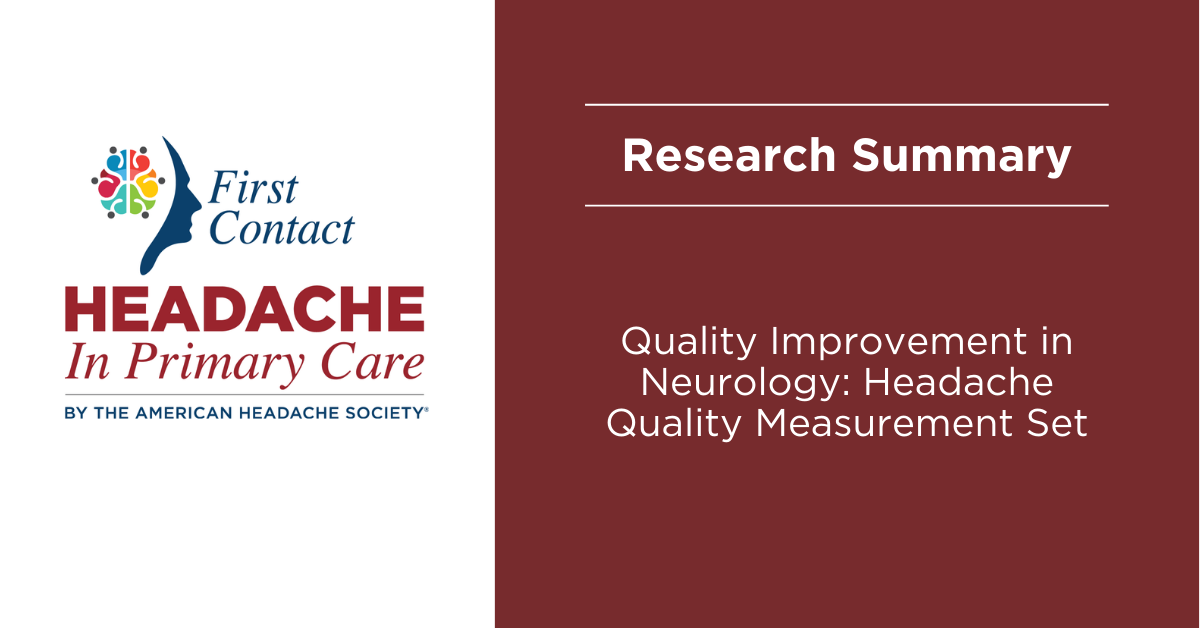
Research Summary: Quality Improvement in Neurology – Headache Quality Measurement Set
Headache®: The Journal of Head and Face Pain recently published Quality Improvement in Neurology: Headache Quality Measurement Set.
The American Academy of Neurology (AAN) and the American Headache Society (AHS) formed a work group of team members that care for patients with headache to provide an update for quality measure for headache. The headache quality measure was first published by the AAN in 2015 to provide a standard to measure and improve care for patients with headache disorders.
Study Overview
Objective
To provide an update for quality measures for headache, first published by the American Academy of Neurology in 2015, that were created to provide a standard to measure and improve care for patients with headache disorders.
Study Methods
- American Academy of Neurology (AAN) and the American Headache Society (AHS) formed a work group of key stakeholders from team members that care for patients with headache (nominated through the AAN)
- Quality measures were developed in the following way:
- Evidence-based literature search
- Establish multidisciplinary work group adhering to the AAN conflict of interest policy
- Drafting candidate measures and technical specifications
- Convening the work group virtually to review candidate measures
- Refining and discussion of the candidate measures
- Soliciting public comments on approved measures during a 21-day period
- Refining the final measures according to the input received during the public comment period and corresponding technical specifications
- Obtaining approval from the work group, AAN Quality Measures Subcommittee, AAN Quality Committee, AAN Institute Board of Directions, AHS Board of Directors
Study Results
The six measures were approved
- Documentation of Migraine Frequency – proper assessment of migraine attack frequency is required to initiate preventive therapy.
- Modifiable Lifestyle and Chronification Factors Counseling for Migraine – assess and counsel patients about modifiable risk factors, especially those that can contribute to progression to chronic migraine (for example: stress, poor sleep hygiene, alcohol, caffeine, acute medication overuse)
- Treatment Prescribed for Acute Migraine Attack – undertreating acute migraine attacks can lead to progression to chronic migraine (with precaution to avoid acute medication overuse)
- Migraine Preventive Therapy Management – prevention should be offered when patients have six or more monthly migraine attacks, three or more migraine attacks with some impairment, or two or more migraine attacks with severe impairment.
- Acute and Preventive Treatment Prescribed for Cluster Headache – formulate a treatment strategy to decrease attack burden, frequency and severity.
- Proposed Concepts and Retired Measures – five measures were not approved because evidence was lacking or were not feasible to implement in clinical practice. Some measures were retired.
Implications for Primary Care Physicians
- New and updated quality measures now reflect evidenced-based advances in migraine therapy, assessment and prevention.
- Primary care physicians can use these measures to help make appropriate diagnoses, adjustments to lifestyle practices, formulate acute treatment plans and prevention strategies.
- Clinicians can use these patient-centered tools in their everyday practice when assessing and treating patients with headache disorders.
This summary is part of the First Contact — Headache in Primary Care initiative, an American Headache Society program that provides educational resources to empower healthcare professionals and improve headache and migraine care. We encourage providers in all stages of their careers to visit our homepage to access educational tools to improve patient care.


